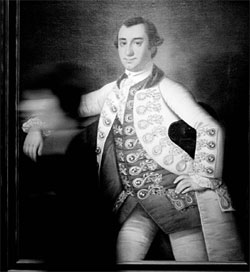| Tools: Save | Print | E-mail | Most Read |
| Grand Brushstrokes of History |
| Adjust font size: |
Sitting on a small folding stool, Wang Yifan, a primary school student in Beijing, worked attentively on his pastel drawing, an imitation of an exotic landscape oil painting hanging in the National Art Museum of China on February 11. The oil painting he was trying to copy was created in 1826 by famed American landscape artist Thomas Cole (1801-1848) and is entitled Landscape with Figures: A Scene from "The Last of the Mohicans". Accompanied by his parents, Wang, like hundreds of other primary students, traded his weekend for a free, on-site drawing lesson arranged by the public education department of the museum. The kids were offered 10 sheets of drawing papers, each featuring a roughly outlined image from the more than 130 works by nearly 120 American artists at the grand exhibition of Art In America: 300 Years Of Innovation. "I was deeply moved by the scene at the art museum," said Li Liqiang, a retiree who attended the exhibition, which opened last Friday. "For a young child, an intimate encounter with foreign art, such as American art, can sow the seeds of understanding of other cultures," he said. His views were echoed by Fan Di'an, director of the museum. This exhibition is "the fruit of the friendship between the Chinese and American peoples, and an indication of further artistic exchanges between these two nations in the 21st Century," said Fan. He said the exhibition would give Chinese viewers "a glimpse into American art and an opportunity to understand how it relates to art worldwide". Touted as the largest collection of American art to be shown in China and the first to reflect the history of art in the United States, the exhibition is hosted by the National Art Museum of China and organized by the Solomon R. Guggenheim Foundation of New York and the Terra Foundation for American Art of Chicago. "It is the first time ever in history that American artworks on such a huge scale have been brought together in a single show for art lovers," Fan said. "Art lovers should not miss it." The exhibition is a response to the hugely successfully exhibition China: 5,000 Years presented to American viewers in 1998 at the Guggenheim Museum SoHo and Solomon R. Guggenheim Museum in New York, according to Thomas Krens, director of the Solomon R. Guggenheim Foundation. The exhibition is divided into six sections and spans the following periods: Colonization and Rebellion (1700-1830), Expansion and Fragmentation (1830-1880), Cosmopolitanism and Nationalism (1880-1915), Modernism and Regionalism (1915-1945), Prosperity and Disillusionment (1945-1980) and Multiculturalism and Globalization (1980-present), according to Susan Davidson, senior curator with the Solomon R. Guggenheim Museum. "All of these show how American culture has constantly modified itself in the course of social development to adapt and innovate in an enterprising spirit," said Elizabeth Glassman, president and CEO, Terra Foundation for American Art, in Beijing. Between the early 18th and the late 19th Century, American art was mostly realist, presenting the glories of life, natural scenes, and social life in brilliant colors on canvas. The exhibition begins with the resolute portrait of an Indian from 1735, and Benjamin West's Penn's Treaty with the Indians (1771-72) quietly opens the curtain on the drama of European colonialism. Gilbert Stuart's classic portrait of George Washington makes American unification and independence powerfully clear. Other portraits from this period reflect a vitality even hundreds of years after their creation. In the late 19th and early 20th Centuries, a great number of American artists were active internationally including John Singer Sargent and Mary Cassatt. "They were deeply versed in European technique and taste, yet committed to creating an American art with distinct characteristics," noted Michael Leja, an art historian with the University of Pennsylvania, at an academic lecture delivered to Chinese audiences last Sunday at the National Art Museum of China. In the period of World War II, the United States replaced Europe as an artistic center, and this is an important part of the current exhibition, where the works of many modern masters are assembled. The exhibition also shows the works of some modern American artists who are better known in Chinese art communities. Among them are Abstract Expressionist artist Jackson Pollock's 1942 work The Moon-Woman and the 1950 work Number 18. Also on display are masterpieces created by Pop Art pioneer Andy Warhol and Robert Rauschenberg. Warhol's 1963 work Race Riot, reflects racial tensions in the United States. The exhibition also features certain works of ethnic Chinese artists working in the United States. The appearance of these artists should be of particular interest to Chinese viewers. "Viewing this exhibition is analogous to reading a very thick history of American art," said Leja. (China Daily February 26, 2007) |
| Tools: Save | Print | E-mail | Most Read |
 |
| Related Stories |
|
